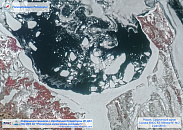The hydrometeorological designation system Meteor-3M was developed in 2009, when the first satellite of this type, Meteor-M №1, was launched. It performed tasks in the interests of operational meteorology, hydrology, agrometeorology, climate and environmental monitoring. On July 8, 2014, the spacecraft Meteor-M №2 was launched. Both satellites were equipped with a multi-channel satellite imaging system (MCSIS) consisting of 3 cameras. On November 28, 2017, it was planned to put the Meteor-M №2-1 satellite into orbit, but this was not possible, the satellite did not come in contact and is considered lost.
Spacecraft design and mission details
|
Name |
Meteor-M №2 |
|---|---|
|
Country |
Russia |
|
Developer |
VNIIEM Corporation |
|
Operator |
Nts OMZ |
|
Launch vehicle |
Soyuz-2 |
|
Launch date |
8 July 2014 |
|
Launch site |
Baikonur Cosmodrome |
|
Date of deactivation |
- |
|
Orbit: Type Altitude, km Inclination, deg. |
Sun-synchronous 832 98,8 |
|
Mission duration, years |
5 |
|
Revisit frequency, days |
0,5-1 |
|
Mass, kg |
2900 |
The satellite has hydrometeorological equipment and operational monitoring equipment onboard. Thus, a multichannel scanning device of low resolution (MSD-LR) was installed onboard the spacecraft, almost the complete analogue of the AVHRR instrument working on NOAA and MetOp satellites, which allows increasing the repeatability of surveying the same territory with similar instruments up to 10-15 images per da. In order for users to access MSD-LR data continuously and freely transmitted from the satellite in an open broadcast DB mode, only an L-band receiving station is needed.
Also, the spacecraft "Meteor-M" №2 has the necessary equipment designed to receive:
- multispectral images of the Earth's surface;
- quantitative measurement of radiation leaving the Earth in various spectral ranges;
- heliophysical information about processes on the Sun and in near-Earth space;
- data from automatic measurement platforms of various types (ground and drifting);
- located in any (including polar) areas of the Earth.
Specifications
|
Equipment |
Applications |
Sensor bands |
Swath, km |
Spatial resolution |
|
MSD-LR |
Global and regional mapping of cloudiness, ocean and land surface temperatures |
6 bands: 1,6 – 1,8 µm; 3,5 – 4,1 µm; 10,5 – 11,5 µm; 11,5 – 12,5 µm. |
≥2800 |
1 km |
|
MCSIS |
Local mapping of the underlying surface |
6 bands: 0,450 – 0,510 µm; 0,535 – 0,575 µm; 0,580 – 0,690 µm; 0,630 – 0,680 µm; 0,760 – 0,900 µm. |
450, 900 |
50 m / 100 m |
Applications:
- weather forecasting, both locally and globally;
- analysis of the state of the seas and oceans;
- ice control;
- analysis of heliogeophysical conditions in near-Earth space (GST);
- analysis of the state of the ionosphere and the magnetic field of the Earth;
- climatology (including tracking global climate change);
- emergency monitoring;
- environmental monitoring.



